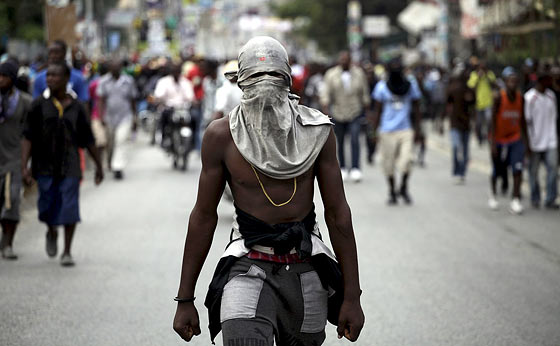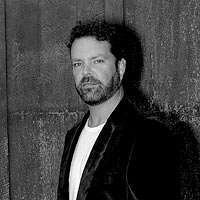Surviving Haiti – A Real World SHTF Environment

Eric Borton relates and reflects upon his personal experiences in a real-world SHTF environment (Haiti) while pointing out some of his ‘lessons learned’ such as “being prepared is more than just having the gear or the guns” and “surviving in that environment was more about awareness, mental and physical preparation, and avoidance”.
Awareness was the single most valuable tool that he carried – something that you can’t see or touch…
By Eric E. Borton:
I had the high ground and good cover when they both came through a doorway into a small courtyard below me. One had a revolver tucked into his belt and the other had a semi-automatic pistol he was returning to a holster. It was late into the evening when I spotted them coming over the wall under the cover of darkness at our compound. Another man was sitting behind the wheel of a vehicle parked outside the gate. They came up the road without headlights.
A few moments before they appeared in my sights, I heard a scuffle and cries of terror coming from our security shack. Standing over my targets I had two options. Light them up with the flashlight on the end of my gun, or light them up with the trigger.
We prepare for natural disasters, economic collapse, political unrest, and desperate people looking to take what we have. In Haiti, we dealt with all four every day. Over the past year and a half, I spent most of that time in Port-au-Prince consulting for a rescue helicopter program. In most of the crumbling city, it’s as if the devastating earthquake in 2010 happened yesterday…
I write novels about what the world would look like after an apocalyptic event in my WITHOUT series. Haiti is the real-world SHTF environment that we read about in fiction. Being prepared saved my life. It also saved a few of theirs.
My first trip was for ten days. It took ten seconds to realize how grossly underprepared I was for the hostile foreign environment. The Americans who were already in country relied on private companies to provide security at their living quarters and at the hangar. There was no security detail when traveling between the two or during excursions into the city. Outside in the chaos we were on our own.
I lived in an apartment within a walled compound in the mountains above Port-au-Prince. We had one guard at the gate who carried a shotgun that looked like he pulled it out of a river. Rolling blackouts and gunfire were a nightly occurrence. Sleep was hard to come by those first few evenings until I became acclimated to the things that went bump in the night.
Most of the homes on our mountainside had diesel generators and rainwater collection systems instead of trusting the very unreliable city utilities. The area was considered one of the most affluent sections of the city. It was also one of the most popular targets for raids by gangs coming from the most dangerous sections of the city. (During one of the raids, a gang member was caught by the locals and set on fire in a city square as a deterrent for the others. It didn’t work.)
When I returned home from the first trip, it took me several days to spool down. I spent six years in Naval Intelligence and traveled to many third world counties. The difference with Haiti was that I didn’t have the U.S. Navy watching my back. One might ask why I returned eleven more times to one of the most dangerous countries in our hemisphere. For me, the answer is simple. It’s how I keep my edge. Most of the visitors to this site will understand what I mean. Those who don’t prepare, won’t.
My philosophy is that if you’re preparing for the worst, there’s no better way than experiencing the worst. Haiti is that place. At no point can you let your guard down. If you do, Haiti will make you pay.
After I did spool down, I started my checklist for the return trip the following month. One of the first items was a set of Haitian Creole language CDs. I’m by no means fluent, but if I find myself lost or in need of help, I can engage the locals with confidence. I can also give commands when I find myself in situations where they need to be given. That was a daily occurrence.
The next item on the list was a bit trickier. It’s illegal for civilians to carry guns unless they have permission from the head of the Haitian National Police (HNP). The only group more corrupt than the politicians was the HNP. There’s a grey area if you’re former or active duty U.S. military and carry an ID card, but it was still illegal to purchase a gun. To add to the problem, there was a recent ban on importing weapons and ammunition. Without giving away secrets on international gun trade and circumventing foreign customs, that box was checked.
The backpack that never left my side – day or night – contained the items you’d expect: Medical kit, flashlights, ammunition, knives, tools, fire-starters, tarp, cordage, extra clothing, gloves, food, personal hygiene products, and spare batteries. Unique items in my pack for that area were a $10 prepaid cell phone, Haitian cash, local map, compass, and a LifeStraw. (You can literally suck water out of a pothole with that thing…if there was no other option of course.)
The other items not in my pack that you’d expect were on me at all times, except when I slept: Gun, extra magazines, UHF/VHF radio, cell, tactical flashlight, knife, lighter, and multi-tool. They were all secured in the event I needed to go from a stroll to a flat-out sprint without causing a yard sale.
My bug-out plan was based on three modes of transportation at my disposal. Our helicopters were the first choice to get me over to the relative safety of the Dominican Republic (DR). A well-maintained and always fully-fueled 4×4 was my second option if I wasn’t at the hangar. The border to the DR was only thirty-miles away, so hoofing it was an option as well. Haiti is an island country, but the waterfront in Port-au-Prince was lined with the most dangerous areas in the city and were controlled by gangs. Even the police avoided those areas unless they were in a large force, so using the water to escape would be a last resort.
I never considered the U.S. Embassy as an option. I knew where it was and how to get there, but I’d still be in the middle of Port-au-Prince if the SHTF. History has shown us that embassies can be overrun. The same went for the UN peacekeeping compounds within the city. History has also shown that those guys are the first to run and last to shoot. I have no love – or confidence – with UN troops.
As with most bug-out plans, putting distance between you and a city is a high priority. Port-au-Prince is no different, but difficult to navigate in a vehicle or even on foot on a normal day. Streets and bridges are narrow, in terrible condition, and easily blocked. 8 foot walls with razor wire or broken glass embedded along the tops surround most properties, and heavy steel doors block every entrance. There are few places to hide, or avoid contact with people for miles in any direction. If I had the time, my plan was to make my way through the city a few hours before sunrise to limit contact as much as possible. I’m 6’3” and Irish. There would be no “blending” into a crowd.
Haiti showed me that being prepared is more than just having the gear or the guns. That’s the easy part. Surviving in that environment was more about awareness, mental and physical preparation, and avoidance.
Awareness was the single most valuable tool I carried that you can’t see or touch. My head was constantly on a swivel. Whether driving on streets with no traffic laws or using one of the few ATMs, I was always scanning for trouble. Sometimes by just making eye contact you can change someone’s intent. I truly believe awareness combined with confidence is palpable to others around you.
Mental preparation was part of my daily routine. As I brushed my teeth, I would think about the route I would take into work and the alternates I could use if the primary was blocked. I’d check my group messages with our American employees and Haitian counterparts about possible civil unrest or political protest hotspots. While I dressed, I’d think about different scenarios and how I would react to deteriorating conditions both man-made and natural. Before I got in the truck, I’d walk around to make sure the tires were inflated and no foreign objects were stuck in the treads. When the steel door was opened at our compound, Haiti had my undivided attention.
One aspect of preparedness that doesn’t get enough emphasis is physical conditioning. My worst-case scenario was having to make my way to the DR – 30 miles away – on foot. Haiti has some of the highest mountains in the Caribbean, and I’d have to go over them to get out. It’s also one of the hottest countries in the Caribbean. During my last trip in January, the average temperature was 85º. With 35lbs of gear and traveling at night, it would still take me 3-4 days to get to the border.
If I were out of shape, the chances of me making the trek were slim to none. That goes for any bug-out scenario in any environment. If your entire plan is based on driving out of a bad situation, you’re not prepared. Movement is life. If you can’t run, jump, climb, and fight fully loaded, start investing more time and resources on conditioning and less on the gear. (I can’t stress that point enough.)
Avoiding a bad situation is just as important as knowing how to get out of one. During daylight hours and when civil unrest was at a lull, I’d spend some time driving around the city. I’d become familiar with the routes I didn’t need to take and areas I didn’t need to be in.
Port-au-Prince is a maze of confusing roads that don’t show up on any GPS. They can degrade from a concrete street to a goat path within seconds. Haitian criminals are very familiar with every chokepoint in the city. One of their favorite tactics is to box you in with multiple vehicles or trap you at a dead end. They used that tactic on one of our local Haitian employees heading to the bank and robbed her at gunpoint. Nobody in Haiti is immune to crime or gets a pass for being Haitian. If you don’t know what, where, and who to avoid, a dangerous situation can turn deadly in a heartbeat.
I was prepared for the encounter in the courtyard. I was at a location that gave me command of the area below in a gunfight. Taking a life is a burden that is carried forever regardless of the circumstance. I chose the light over the trigger. Knowing the language saved their lives and I saved myself more nightmares.
In Creole, I yelled down for them to freeze. If their hands went to their guns, I wouldn’t have hesitated to kill them. They froze and then followed my commands. I could see the fear on their faces while they were being blinded and disoriented by my light.
They were employees of the private security company for our compound. They showed up to teach the sleeping guard a lesson when he missed their radio call. After they scared the life out of their own employee, they were going to walk the perimeter to make sure we were safe.
Haiti is one of the most beautiful and exotic countries I’ve ever visited. For the most part, the Haitian people are resilient, proud, and welcoming…but not all of them. I’ve always believed the most dangerous animals on the planet are parents protecting their children. In Port-au-Prince, most live in squalor and struggle to survive and provide for their families every day. The combined dollar amount of the items I carried in my pack was more than what most families made in a year.
I’m sure on more than one occasion a kind and gentle father thought about bashing my head in with a rock to take what I had. Not because he was evil, but because he was desperate.
Stay aware. Stay prepared.
Eric E. Borton served six years with Naval Intelligence in North Africa, Southern Europe, and the Middle East. As a civilian, he served thirteen years with a rescue helicopter service in Atlanta, Georgia, where he currently resides. He is the author of the Post-Apocalyptic series WITHOUT.
Among the highest priorities for survival is safe drinking water.
AlexaPure Pro Gravity-Powered Water Filtration
Tested against NSF/ANSI 53, NSF/ANSI 42


